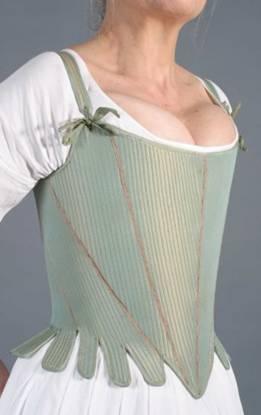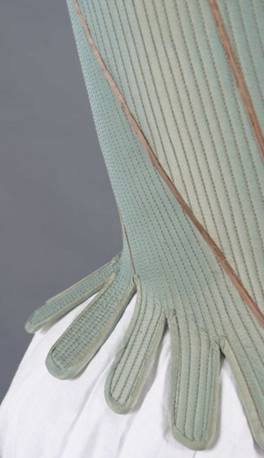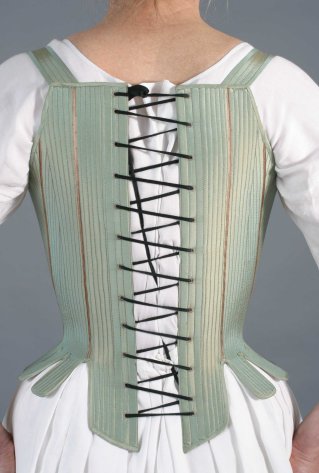
Silk Taffeta Stays - mid 18th century
These stays are suitable for the middle and upper classes. They are made of silk and so would have only been worn by the wealthier classes but are not as rich and expensive as the brocade pair on this site.
Working women or the poor would have only worn stays of linen or wool with the cheapest form of stay being made of leather.
 These stays are fully boned. This meant that every channel sewn by the staymaker was filled with whalebone producing a stiff yet flexible exo-skeleton around the body. Each panel of the stays is boned in the direction that is best to shape and support the body forming it into the desired fashionable cone shape.
These stays are fully boned. This meant that every channel sewn by the staymaker was filled with whalebone producing a stiff yet flexible exo-skeleton around the body. Each panel of the stays is boned in the direction that is best to shape and support the body forming it into the desired fashionable cone shape.
The tabs at the waist serve a very important function. If the stays simply finished at the waistline they would dig into the flesh on the hip. Instead the boning is continued down into the tabs. As the stays are laced on, the tabs spread apart and act as a pressure release mechanism.
 Stays were usually sewn with off set eyelets. All the eyelets were worked by hand since metal eyelets do not come into use till 1823. Even on the best quality stays the eyelets are often very roughly sewn since it was strength and not beauty that mattered.
Stays were usually sewn with off set eyelets. All the eyelets were worked by hand since metal eyelets do not come into use till 1823. Even on the best quality stays the eyelets are often very roughly sewn since it was strength and not beauty that mattered.
One lace is used to literally sew the two sides together. If laced correctly the stays will lie level at top and bottom but if laced with two ends the stays will twist and lie crooked. Sometimes a knot may have been used to secure the end of the lace at the waist enabling the wearer to undo herself with one pull.
